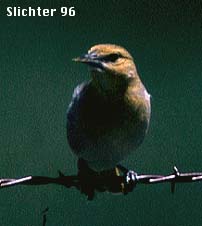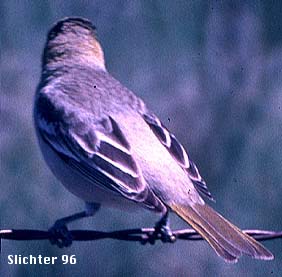

 Female Northern Oriole at Silver
Lake, OR.......July 1996.
Female Northern Oriole at Silver
Lake, OR.......July 1996.
1. Adult male Baltimore Orioles have black backs and heads, orange bellies, shoulders, and rumps, and black tails with orange patches.
2. Adult female Baltimore Orioles are brownish-olive above with dark heads. The underparts are a dull orange, being lightest on the belly.
3. Adult male Bullocks Orioles are similar to the male Baltimore Orioles except they have orange faces with a thin black horizontal line through the eye and white wing patches o the upper wing.
4. Adult female Bullock's Orioles are a gray-olive color above, with yellowish head and breast and a buffy white belly.
5. Both races are bout 9 inches long. They are similar in size and form to blackbirds.
6. The bill is long, thin and sharply pointed.
7. the food consits of insects such as beetles, bugs, moths, ants, and caterpillars. Caterpillars may make up as much as 33 percent of the diet. They also feed on fruit, garden peas, and the nectar from such flowers as plum, cherries, serviceberrry, and blueberry. They can be attracted to home feeders with special nectar feeders or oranges split in half.
8. Northern orioles make unique, beautiful nests. Nests are well-woven, deep pouches which are suspended from the end of long, drooping branches. They are often placed as high as 30 feet off of the ground. The trees most frequently chosen for nest building include cottonwoods or poplars, maples, birch and alder, and oaks. The nests are constructed of strips of plant fibers, hair, and cloth or string fibers. The insides of nests may be lined with fine grasses, hair, or wool. Breding pairs tend to return to the same nest site each year.
9. The females lay from 4 to 6 eggs in the hanging nest. The eggs are incubated for 12 to 14 days. Both parents care for the young and the young leave the nest, but stay as a family unit after about two weeks of care.